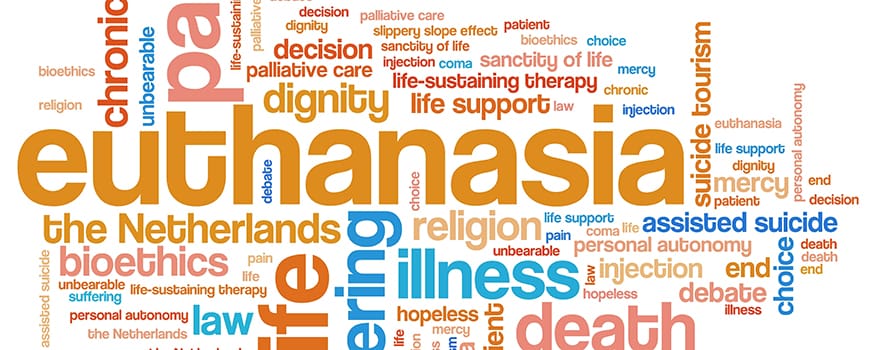“I fear the power of life and death at human hands. I know no one, not myself nor any other, whom I would trust this power.” — Margaret Meade
A few years ago, my sister Patty was trying to convince me that it was time to put down my dog, Zach. We were sitting together having a pedicure at the spa when Patty brought up the subject again. She ended by saying, “Leah, what would you do if mother was in the same shape as Zach?” Startled, I replied, “Well, I certainly wouldn’t put her down!” At this, all the ladies in the spa stopped what they were doing or saying. You could have heard a pin drop. Into the silence, Patty spluttered, “I didn’t mean that… I mean that isn’t what I was suggesting…That is, I would never…Oh dear!”
The easiest, and most objective way to begin a discussion of intentionally caused death (and this much I can tell you: this topic will dominate the medical-ethical world for the next decade) is with the dictionary definitions* of each type.
Suicide is defined as “the act or an instance of taking one’s own life voluntarily and intentionally.” Physician-assisted suicide is “suicide by a patient facilitated by means (as a drug prescription) or by information (as an indication of a lethal dosage) provided by a physician who is aware of the patient’s intent.” And mercy killing (euthanasia) is defined as “the killing of someone who is very sick or injured in order to prevent any further suffering.” The one thing they have in common is that somebody ends up dead. However, the first two clearly involve the individuals’ knowledge, consent and participation — all three are necessary components of both acts. The last, mercy killing, does not necessarily involve the knowledge, consent, or participation of the one to be killed.
For the most part, people don’t want to die, no matter what their minds contemplate or their mouths say. There is an inborn will to live that is difficult to overcome, and outside of mental illness, there has to be a compelling reason for any person to overcome this drive and actually kill themselves. Yet those who are very sick or injured, and particularly those who cannot speak for themselves, present the most difficult medical-ethical issues.
Suicide
Suicide is the tenth leading cause of death in the United States, and advocates claim that there are 25 attempts for every one death. In 2014, the highest suicide rate (19.3/100,000 individuals) was among people age 85 or older. The second highest rate (19.2) occurred in those between age 45 and 64. Younger groups have had consistently lower suicide rates than middle-aged and older adults. In 2014, adolescents and young adults age 15 to 24 had a suicide rate of 11.6. However, in general, the rate of suicide is highest in middle age, white men in particular. White males accounted for 7 of 10 suicides in 2014. Firearms account for almost 50% of all suicides. While males are four times more likely than females to die by suicide, females attempt suicide three times as often as males. The ratio of suicide attempts to suicide death in youth is estimated to be about 25:1, compared to about 4:1 in the elderly.
According to Alex Lickerman, MD, the six reasons why people try to kill themselves are:
- They’re depressed. This is without question the most common reason people commit suicide. The state of depression warps their thinking, allowing ideas like “Everyone would all be better off without me” to make rational sense. Because depression, as we all know, is almost always treatable, almost no one thinks depressed people should be encouraged to commit suicide.
- They’re psychotic. Psychosis is much harder to mask than depression — and arguably even more tragic. Many of these people’s lives while difficult, are manageable with medication. Psychosis, too, is treatable and therefore, once again, few think that suicide should be encouraged in this population.
- They’re impulsive. Some people become maudlin when drinking or on drugs, and impulsively attempt to end their own lives. Once sobered and calmed, these people almost never truly want to die. The remorse is usually genuine, even though some may try it again. Almost no one thinks they should be encouraged to commit suicide.
- They’re crying out for help and don’t know how else to get it. The typical example of this is a young teenage girl suffering genuine angst because of a relationship, either with a friend, a boyfriend, or a parent, who swallows a bottle of Tylenol—not realizing that, in high enough doses, Tylenol causes irreversible liver damage. No one thinks that suicide should be encouraged in this group.
- They’ve made a mistake. This is a recent phenomenon in which typically young people flirt with oxygen deprivation for the sexual or emotional high it brings, and simply go too far. Suicide was never the intended outcome, but they certainly do need some education.
- They have a philosophical desire to die. The decision to commit suicide for some is based on a reasoned decision often motivated by the presence of a painful terminal illness from which little to no hope of reprieve exists. These people aren’t depressed, psychotic, maudlin, or crying out for help. They’re trying to take control of their destiny and alleviate their own suffering. It is this population that advocates of “death with dignity” most typically cite, which brings us to physician-assisted suicide.
Physician-assisted suicide
Five states currently have physician-assisted dying statutes in effect: Oregon since 1997, Washington since 2009 (the law was passed in 2008), Vermont since 2013, and California since June 9, 2016. In Montana, physician-assisted death is legal (since 2009) by the state Supreme Court ruling, but there is no legislation to date. To qualify for a prescription of medication under existing physician-assisted dying laws, you must be:
- an adult resident of Oregon, Washington, Vermont, or California
- mentally competent, that is, capable of making and communicating your healthcare decisions
- diagnosed with a terminal illness that will lead to death within 6 months.
You also must be able to self-administer and ingest the prescribed medication. Two physicians must determine whether all these criteria have been met. The process entails two oral requests, one written request, waiting periods, and other requirements. There are no exceptions to these requirements. Moreover, federal funding, including Medicaid and Medicare, cannot be used for services or medications received under these laws.
According to DeathWithDignity.org:
“In 2014, a total of 155 terminally-ill adult Oregonians received a prescription for medications under the provisions of the Oregon Death with Dignity Act, while 105 of them (67.7%) ingested the medications to die peacefully. This corresponds to 31 Death with Dignity Act deaths per 10,000 total deaths, or 0.31%. Since 1998, when the first person in Oregon took medication prescribed under the Death with Dignity Act, a total of 1,327 patients have received the prescription, of whom 859 (65%) ingested it and died. In Washington, 176 individuals received medications in 2014, of whom 126 died after ingesting the medication, 17 died without having ingested the medication, and for the remaining 27 people who died ingestion status is unknown. Since Washington’s law was passed in 2008, a total of 725 people have had prescriptions written under the Act, and 712 patients have died from ingesting the medications.
“These figures highlight that only a small number of people use the law to die; and that more than one third of those who do obtain the medication prescribed under the law never take it.”
Now, here’s the rub: none of these states, neither Oregon nor any other, has allocated money to enforce the law — to make sure that the criteria are met and that the patient administers the drug to himself or herself. So everything depends upon voluntary reporting. Nonetheless, there really are not too many people who have taken advantage of the law, probably due to the aforementioned will to live, so that by the time they might have taken a lethal prescription, they no longer are able to self-administer.
Mercy killing (euthanasia)
The real issues are not, and almost never have been the problems facing mentally competent adults when they face inevitable death. The real problems, at least for health professionals, lie among those who are not legally incompetent. And while there are many who claim that active euthanasia is widely practiced by physicians, I can only say that this has not been my experience. In fact, many strive, perhaps too mightily, to keep the patient alive. Euthanasia, at least as the term is presently used, involves active, intentional killing, however, kindly it may be done. It generally is divided into different categories:
- Voluntary euthanasia is when a person who cannot kill himself or herself (this could be for physical or psychological reasons) is killed upon that person’s request for reasons of ending suffering. One example of this is the plight of an elderly couple, one of whom asks the other to end that person’s life, usually for reasons of disability but sometimes for financial or other reasons. By and large, most people would prefer to die with, and perhaps by the hand of, a loved one. However, as my mother pointed out, many elderly men kill their physically or mentally challenged wives, and yet very few wives kill their dependent husbands. According to Donna Cohen, a professor of psychiatry and behavioral sciences at the University of South Florida who was quoted in an article by Christine Cosgrove on WebMD, “The wife does not want to die and is often shot in her sleep. If she was awake at the time, there are usually signs that she tried to defend herself.”
- Nonvoluntary euthanasia is the mercy killing of a medically or legally incompetent person who is suffering but incapable of speaking/acting.
- Involuntary euthanasia is the mercy killing of any incompetent person (child, person with serious mental illness or dementia), at the request of a caregiver or next of kin or guardian.
Where the person has no input or no consent and does not participate in the action, there really is a danger that the mercy will be for the benefit of others — even for a society that is not willing or no longer has the resources to pay for his or her care — and not for the benefit of the patient.
This is the end of the domino effect, so often cited by opponents of any kind of third-party involvement in deciding and implementing a decision to terminate life. Many do not approve of capital punishment, no less killing one who has done no harm because some consider their very existence a burden. This is the nightmare scenario brought to fruition in the Third Reich and then expanded to all those whom society at that time deemed undesirable.
This fear is not unrealistic, as both history and current events demonstrate. While most today agree that treatment cannot be forced, that a person has a right to refuse medical interventions, they are only comfortable with the notion if the decision-making authority is left with the individual. That may or may not include physician-assisted suicide, but only if the physician is strictly limited to writing a prescription and does not actively participate in killing the patient. Moreover, conspiracy theorists (and even some who are not) point out that the state is the guardian of many handicapped and elderly people. My experience is that a ward of the state is most likely kept on life-support for inordinately long periods, but that, of course, could change.
Understanding the issues
This difficult subject will without question affect every nurse and physician. And it is more than time that we discussed, debated, and spoke to the public about these issues, especially as the Baby Boomers age and threaten the solvency of both Social Security and Medicare. And especially since medical science has enabled life-prolonging treatments almost to the point of the grotesque. We need to cut through the issues with Occam’s Razor — simply, clearly, and concisely, and very, very carefully.
*All definitions are from the Merriam Webster Dictionary.
Leah Curtin is Executive Editor, Professional Outreach for American Nurse Today and a consultant with CGFNS International in Philadelphia, Pennsylvania.
Selected references
American Foundation for Suicide Prevention. Suicide statistics.
Death with Dignity. FAQs.
Henden H, Foley K. Physician assisted suicide in Oregon, a medical perspective. Michigan Law Review. 2008;106:1613-45.
Lickerman A. 6 reasons why people commit suicide. medPages KevinMD. June 30, 2010.
Cosgrove C. Depression Health Center. Murder-suicides in elderly rise. WebMD. n.d.



















2 Comments.
The articles I have researched and read on this subject are interesting and informative, but provide no real life examples or situations. I am currently living this nightmare. My younger, 65 year old brother had lived life from 30 to 50 years old mired in the depths of crystal meth usage. Running out of money when he turned 50 he became homeless and was taken in by our younger sister. For 15 years he has been drug free but has lived a life of dependency. His pleasures in life were lying in bed to eat and watch TV and only exercising by going to the porch to have a cigarette. He has no social network or outside interests. While weighing approximately 300 lbs. he developed Hidrantitus supurative stage 3 which led to a UTI, which untreated led to sepsis. He is currently under hospice care which began 3 weeks ago. His weight is down to 170 lbs. and he has developed painful bedsores. The wound care treatment is severely painful for him as is the changing of absorbent pads and bedding. Last night he said he wanted Hospice to “put him out”. When asked to clarify he said he wants to die so the pain can end. In California we have physician assisted death. Sounds like a merciful solution, but wait. We must get the approval of two doctors, sign paperwork, wait 15 days, sign more paperwork and then, probably 3 weeks or more from now, he must be able to pick up the pills that were prescribed and take them himself. Does this sound like a good solution for my brother? There must be a simpler, faster, more humane way to reach the desired end result.
Dear Editor:
I am writing a response in regards to the article “Suicide, physician-assisted suicide and mercy killing: Similarities, differences, cautions, and precautions”, written in August 2016 Vol, 11 No. 8. This article inspired a very profound reaction within myself, both professionally and personally. This is a very well written and informative article regarding a subject that is so judgingly talked about in the nursing profession as well as in many other professions. It has inspired me to further research the issue to be a better educated and informed nurse. Although this is not something that my state (North Carolina) currently practices, I feel it may be practiced one day. It is a very controversial subject and in order to actively have an opinion on it we must first fully understand it. Your article helped me to better understand the subject.
The dying experience for every patient is different. I believe, just as your article supports, that death should be something full of comfort and peace, no matter the situation. The beginning of your article focuses on suicide, I would like to focus on the other subjects; physician-assisted suicide and mercy killing. Assisted suicide is defined as “the practice of providing a competent patient with a prescription for medication for the patient to use with the primary intention of ending his or her own life. The New England Journal of Medicine”. Mercy killing or euthanasia is as this article defined “when a person who cannot kill himself or herself is killed upon that persons request for reasons of ending suffering.” I am completely opposed to the thought of suicide, but in the case of ending suffering such as in a hospice/palliative care setting I feel an exception can be made. Your article explains these topics and what they entail very well. As stated above this is a very touchy topic for the public. With the right information explained in the right way the public may be more inclined to, at least, give the subject a chance rather than just throw it out right away. This article does just that, informs without persuading.
I plan to implement the knowledge I have gained from this article into my own nursing career. Although these options are not available to patients in North Carolina I can still ensure a dignifying and comfortable death for every dying patient. With more articles such as this one being published maybe this will become an option for those who are suffering in more states in later years. If so, I as a nurse will now, because of this article, be better informed myself and better prepared to talk about this option with my patients and their families.
Sincerely,
Cassie Garcia, RN